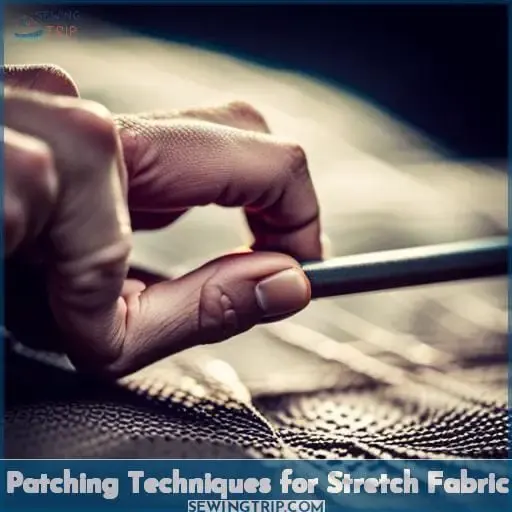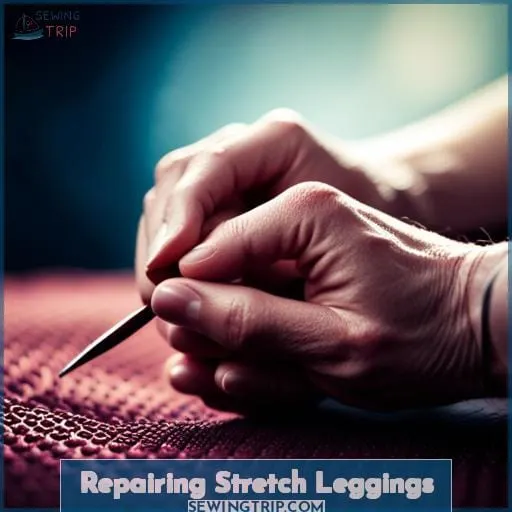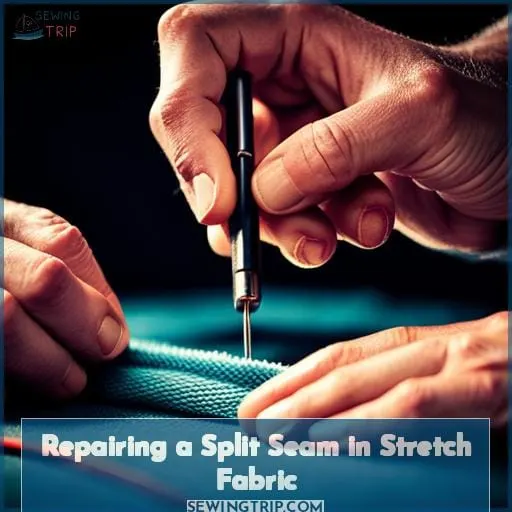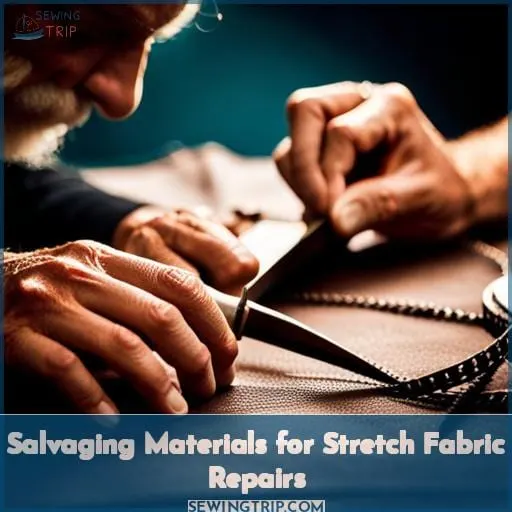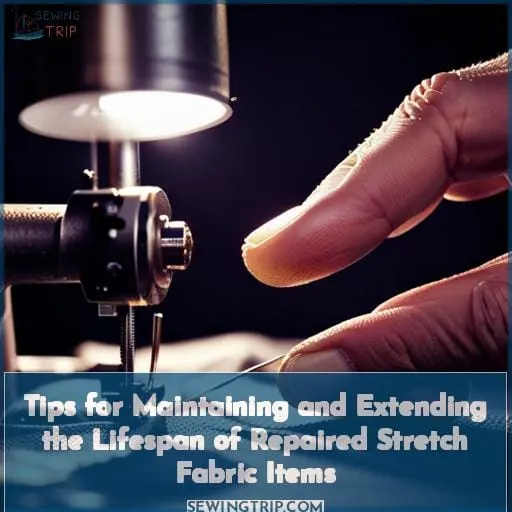This site is supported by our readers. We may earn a commission, at no cost to you, if you purchase through links.
 Imagine discovering a hole in your favorite stretch fabric garment. Don’t worry, repairing it is easier than you think!
Imagine discovering a hole in your favorite stretch fabric garment. Don’t worry, repairing it is easier than you think!
In this article, we’ll show you step-by-step how to fix a hole in stretch fabric using simple techniques that anyone can master. From sewing on patches to hand-stitching with specialized thread, you’ll learn the secrets of restoring your beloved items back to their former glory.
Say goodbye to those pesky holes and hello to confidence and style!
Table Of Contents
- Key Takeaways
- Mending a Hole in Stretch Fabric
- Patching Techniques for Stretch Fabric
- Fixing a Hole in Spandex Material
- Repairing a Hole in a Swimsuit
- Fixing Holes in Stretchy Jeans
- Repairing Stretch Leggings
- Repairing a Split Seam in Stretch Fabric
- Can You Fuse or Glue a Patch in Place on Stretch Fabric?
- Salvaging Materials for Stretch Fabric Repairs
- Tips for Maintaining and Extending the Lifespan of Repaired Stretch Fabric Items
- Frequently Asked Questions (FAQs)
- Conclusion
Key Takeaways
- Identify the hole and gather necessary materials
- Choose compatible materials and techniques for specific fabric types
- Utilize fusible bonding web and darning techniques for secure and cost-effective bonding
- Reuse old garments or spare fabric for patches to save costs and consider fabric recycling for patching material
Mending a Hole in Stretch Fabric
To mend a hole in stretch fabric, you’ll need to gather the necessary materials and follow a step-by-step process.
Start by identifying the hole and preparing your sewing tools such as needles, thread, scissors, and spare fabric that matches the garment.
When patching holes in stretchy fabrics like spandex or leggings, it’s important to use reinforcement techniques for longevity.
Choose compatible materials that have similar stretching properties to avoid compromising flexibility after repair.
Employ stitching precision by securing patches with multiple passes around their perimeter for durability.
By using sustainable repairs and taking care of your garments through these methods, you can extend their lifespan while maintaining their stretchiness.
Patching Techniques for Stretch Fabric
Now that you have identified the various patching techniques for stretch fabric, let’s explore each method in more detail.
From using a patch and zig-zag stitch to employing adhesive web and a patch, there are multiple options available depending on your preferences and the type of fabric you’re working with.
Whether you choose to use a sewing machine or prefer hand-stitching, these techniques will help you effectively repair holes in your favorite stretchy garments.
Method 1: Using a Patch and Zig-zag Stitch
To repair a hole in stretch fabric, start by using a patch and zig-zag stitch for optimal durability.
Choose a patch design that matches the garment’s color and pattern to ensure seamless integration.
When stitching, reinforce the edges of the hole with multiple passes to prevent further damage.
Consider fabric compatibility to maintain flexibility after repair.
These reinforcement techniques won’t only fix the hole but also enhance repair aesthetics for your swimsuit or favorite pair of stretchy jeans.
Method 2: Using Adhesive Web and Patch
You can easily repair a hole in stretch fabric using adhesive web and a patch.
Adhesive web is available in various types, so make sure to choose one with heat tolerance suitable for your fabric.
When selecting a patch, consider color matching for seamless blending.
This quick fix method is convenient for patching spandex garments and other stretch fabrics.
Ensure the adhesive web and the material are compatible to achieve long-lasting repairs on your favorite clothing items.
Method 3: Sewing Machine Repair
Now let’s move on to another method for repairing holes in stretch fabric: using your sewing machine.
When it comes to sewing machine repair, the right settings are crucial.
- Adjust your machine settings to accommodate the fabric type and thickness.
- Select a thread that matches or complements the garment color for seamless blending.
- Choose needle types specifically designed for stretch fabrics, as they prevent snagging and ensure smooth stitching.
- Lastly, reinforce the repaired area with additional stitches or patches for added durability and longevity.
Machine Settings, Thread Selection, Needle Types,Fabric Compatibility, Reinforcement Techniques
Method 4: Hand-stitching
Start by gathering the necessary materials for hand-stitching, including a needle, matching thread, pins, scissors, and spare fabric for patching.
When using hand-stitching to repair holes in stretch fabric, follow these precision techniques:
- Secure the hole with small stitches around its perimeter.
- Use reinforcing methods like backstitches or whipstitches to strengthen the patch.
- Consider adding artistic embellishments or custom embroidery for a personalized touch.
- Pay attention to finishing details such as trimming excess threads and ensuring smooth edges.
Hand-stitching is an effective method that allows you to mend stretchy fabrics while showcasing your sewing skills and creativity through decorative touches and reinforcement techniques.
Fixing a Hole in Spandex Material
To successfully mend a hole in spandex material, it’s important to reinforce the fabric using optimal stitching techniques.
Stitching techniques for stretch fabric repair should focus on elastic restoration and reinforcement methods that ensure durability without compromising flexibility.
Custom patching can be used to cover the hole and provide additional strength to the damaged area.
When choosing materials for patches, consider their compatibility with spandex’s stretchy nature.
Whether you’re fixing swimsuit tears or repairing stretch denim, mending holes in stretchy fabrics requires careful attention to detail and precision sewing skills.
By following these fabric patching tips, you can confidently restore your favorite spandex garments back to their original condition.
| Stitching Techniques | Elastic Restoration | Reinforcement Methods |
|---|---|---|
| Optimal stitching methods ensure strong repairs. | Restoring elasticity maintains garment functionality. | Reinforcing patched areas prevents future damage. |
Repairing a Hole in a Swimsuit
To repair a hole in a swimsuit, gather the necessary materials and follow these simple steps:
- Assess Design Considerations: Take into account the design of your swimsuit to ensure that any repairs blend seamlessly with the original style.
- Preserve Elasticity: Use techniques like fusible bonding web or hand-stitching to mend stretchy fabric holes without compromising its elasticity.
- Consider Chlorine Impact: If your swimsuit is frequently exposed to chlorine, opt for durable repair methods that can withstand its corrosive effects.
- Saltwater Repairs: For swimwear used in saltwater environments, choose materials and stitching techniques that are resistant to saltwater damage.
Fixing Holes in Stretchy Jeans
When it comes to fixing holes in stretchy jeans, the first step is identifying the wear areas such as the inner thigh, knees, or seat.
Once you’ve identified these areas, choose suitable patch materials that match the color and fabric of your jeans.
Optimal stitching techniques are crucial for a strong and lasting repair, so reinforce edges and secure patches with appropriate stitches to prevent future holes.
And remember – using inexpensive jeans for repair material can be a cost-effective solution!
Identifying Wear Areas
Continue identifying wear areas in stretchy jeans for targeted repairs by assessing common problem areas such as the inner thigh, knees, or seat.
Identifying patterns of damage is essential to effectively mend stretchy fabric holes.
By analyzing techniques used in previous repairs and understanding materials, you can explore innovations and examine trends for optimal results.
Don’t overlook moth holes – they too can be repaired using fabric mending techniques specific to stretch fabrics.
Choosing Suitable Patch Materials
When repairing holes in stretchy jeans, you should always consider the wear areas and choose suitable patch materials based on their durability and flexibility.
Here are some fabric patching tips to help you make the right choice:
- Consider the compatibility of the patch material with your garment’s stretch.
- Choose patches that will preserve elasticity and maintain garment integrity.
- Opt for durable materials that can withstand regular wear and washing.
- Select patches that blend seamlessly with your jeans, ensuring a visually appealing repair.
- Use adhesive web for repairs that require a strong bond between the patch and fabric.
By carefully selecting suitable materials, you can ensure longevity in your repairs while preserving both functionality and style.
Optimal Stitching Techniques
- First, sew the patch onto the hole in your stretchy jeans using a zig-zag stitch for optimal durability and flexibility.
- Make sure to select a needle designed for sewing stretch fabrics to prevent snagging or breaking.
- Adjust thread tension and stitch length according to your machine’s settings and fabric thickness.
- Additionally, reinforce the edges of both the patch and surrounding fabric with extra stitching for added strength.
Remember that choosing compatible fabrics is crucial for seamless repairs.
Needle Selection, Thread Tension, Stitch Length, Reinforcement Methods, Fabric Compatibility
Cost-effective Repairs
To ensure cost-effective repairs for fixing holes in stretchy jeans, consider the wear areas and choose suitable patch materials. Opt for budget-friendly methods that promote sustainable approaches and material reusability.
By employing economical fixes, you can mend your stretch fabric garments without breaking the bank. These frugal solutions not only save money but also extend the lifespan of your favorite jeans while preventing moth infestation.
Follow these fabric patching tips to master mending stretchy fabric holes with ease.
Repairing Stretch Leggings
Now let’s talk about repairing stretch leggings.
Whether you’re dealing with a small hole or a larger tear, there are several methods you can use to fix them.
You can choose to use a serger for quick and professional-looking repairs, opt for your trusty sewing machine for more control, or even hand-stitch with beeswax-coated thread for added strength.
Using a Serger
Start by serging the damaged area of your stretch leggings for a secure and professional repair.
Serging, also known as overlocking, offers several benefits when it comes to mending fabric.
The serger’s specialized stitch creates strong and durable seams that prevent fraying and unraveling.
Compared to using a regular sewing machine, a serger provides faster stitching with its multiple threads simultaneously securing the fabric edges.
It’s an essential tool for garment mending methods like patch sewing techniques or repairing holes in stretchy fabrics like leggings.
Using a Sewing Machine
Begin by threading your sewing machine and selecting the appropriate stitch for repairing the holes in stretch leggings.
- Choose a zig-zag or stretch stitch to accommodate the fabric’s elasticity.
- Adjust tension settings to prevent puckering or stretching of the repaired area.
- Use a ballpoint needle specifically designed for knit fabrics, ensuring smooth stitching without damaging fibers.
- Select thread that matches both color and weight of your leggings for seamless blending.
- Practice on scrap fabric before tackling the actual repair to perfect your technique.
Hand-stitching With Beeswax-coated Thread
By hand-stitching with beeswax-coated thread, you can effectively repair holes in stretch leggings. This method offers several benefits, including the ability to create eco-friendly repairs and unleash your creativity through fabric mending techniques.
In addition to its durability, beeswax coating on the thread provides advantages such as smooth sewing and reduced tangling. Hand-stitching allows for precise control over the stitches and offers an alternative stitch method to adhesive web for repairs.
Try this technique for mastering garment mending methods using a personal touch!
Repairing a Split Seam in Stretch Fabric
To repair a split seam in stretch fabric, you can easily mend it using a few simple steps:
- Assess the damage:
- Identify the extent of the split seam.
- Determine if any reinforcement techniques are necessary.
- Choose appropriate stitching methods:
- Select a stitch that will provide both strength and flexibility to maintain seam integrity.
- Options like zig-zag stitches or stretch stitches work well for repairing stretch fabric.
- Strengthen the seam:
- Use reinforcement techniques such as backstitching or adding an extra row of stitching along the damaged area to ensure long-lasting repairs.
- Consider thread choices:
- Opt for threads specifically designed for sewing on stretch fabrics, as they offer better elasticity and durability compared to regular threads.
By following these guidelines, you can successfully repair a split seam in your favorite piece of stretch fabric while maintaining its functionality and appearance.
Can You Fuse or Glue a Patch in Place on Stretch Fabric?
You can fuse or glue a patch in place on stretch fabric for a quick and easy repair.
Adhesive applications provide convenient fusion techniques and bonding solutions that adhere the patch securely to the fabric.
Glue alternatives, such as adhesive web, offer an effective option for repairing stretch fabrics without the need for extensive hand-stitching.
This patch sewing technique is especially useful when dealing with small holes or tears in garments made from spandex, lycra, or other stretchy materials.
Simply cut a piece of adhesive web slightly larger than the hole, position it over the damaged area on the inside of your garment, cover it with lightweight stabilizer if needed to protect surrounding fabric layers from heat damage during ironing process (optional), then apply heat using an iron set at medium-high temperature until adhesion occurs between both surfaces – usually around 10-15 seconds.
Salvaging Materials for Stretch Fabric Repairs
When repairing a hole in stretch fabric, one way to save money and ensure color and material match is by salvaging materials from old garments or spare fabric.
- Materials Reuse: Repurpose old garments or spare fabric to create patches that can be used for repairs.
- Fabric Recycling: Consider recycling worn-out stretch fabric items by cutting them into smaller pieces that can be used as patching material.
- Fusible Bonding Web: Use fusible bonding web to attach the patch onto the damaged area, providing a secure bond without extensive stitching.
- Darning Technique: Employ the darning technique using matching thread colors to mend moth holes or small tears in stretch fabrics.
By utilizing these garment mending methods and following these fabric patching tips, you can’t only repair your favorite stretchy clothing but also contribute towards reducing waste and adopting more sustainable practices.
Tips for Maintaining and Extending the Lifespan of Repaired Stretch Fabric Items
After successfully repairing a hole in your stretch fabric item, it’s important to follow these tips for maintaining and extending the lifespan of the repaired garment:
- Embrace Maintenance Innovations:
- Stay up-to-date with new maintenance techniques and innovations that can enhance the durability of your stretch fabric items.
- This includes using sustainable practices such as eco-friendly detergents and gentle cleaning methods.
- Implement Durability Enhancements:
- Apply strategies to strengthen weak areas prone to damage, like reinforcing seams or adding patches for extra protection against wear and tear.
- Adopt Longevity Strategies:
- Take proactive measures to prevent moth infestation by storing your repaired garments properly in well-sealed containers or bags with moth repellents such as lavender sachets or cedar blocks.
- Master Care Techniques:
- Familiarize yourself with proper care techniques specific to different fabrics like wool and cashmere, including specialized cleaning methods that preserve their softness while preventing shrinkage or distortion.
By incorporating these tips into your routine, you’ll ensure that not only do you repair holes effectively but also extend the life of your beloved stretch fabric items through careful maintenance practices.
Frequently Asked Questions (FAQs)
Can I use regular sewing needles and thread for repairing stretch fabric, or do I need specialized tools?
Yes, regular sewing needles and thread can be used for repairing stretch fabric. However, using a specialized stretch sewing needle and polyester thread matching the garment color can provide better results for durability and flexibility in repairs.
What is the best adhesive to use for securing patches on stretch fabric?
When it comes to securing patches on stretch fabric, the best adhesive is a washable fabric adhesive. This ensures a firm attachment that will withstand movement and washing, giving you peace of mind in your repairs.
How can I prevent the repaired area from becoming stiff or uncomfortable after patching a hole in stretch fabric?
To prevent stiffness or discomfort after patching a hole in stretch fabric, choose a patch material that matches the garment’s stretch.
Secure the patch using optimal stitching techniques and reinforce edges for longevity.
Are there any specific stitching techniques I should use for repairing a split seam in stretch fabric?
To repair a split seam in stretch fabric, use a zig-zag stitch or stretch stitch on your sewing machine.
These stitches allow for flexibility and prevent further tearing.
Secure the ends with backstitching to ensure durability.
Can I machine wash and dry stretch fabric after patching a hole, or do I need to take any special precautions?
After patching a hole in stretch fabric, you can machine wash and dry it without special precautions.
Just remember to use a gentle cycle and low heat settings to preserve the durability of your repair.
Conclusion
To sum it up, repairing a hole in stretch fabric is a simple task that anyone can master.
Whether you’re dealing with spandex, swimsuits, jeans, or leggings, there are various techniques you can use to restore your beloved items back to their former glory.
From patching with adhesive web or zig-zag stitching to hand-stitching with specialized thread, the options are endless.
So say goodbye to those pesky holes and hello to confidence and style in your favorite stretch fabric garments!


